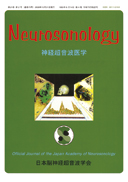巻号一覧

24 巻 (2011)
- 2-3 号 p. 64-
- 1 号 p. 1-
24 巻, 1 号
選択された号の論文の3件中1~3を表示しています
- |<
- <
- 1
- >
- >|
原著
-
久門 良明, 渡邉 英昭, 田川 雅彦, 大西 丘倫, 伊賀瀬 圭二, 松原 一郎, 貞本 和彦原稿種別: 原著
2011 年 24 巻 1 号 p. 1-6
発行日: 2011/10/30
公開日: 2012/10/19
ジャーナル フリーBackground : We evaluated carotid artery stenosis using a three-dimensional (3D) ultrasound (US) imaging system.
Methods : Fifty-one patients who underwent magnetic resonance angiography (MRA) (n = 48), computed tomographic angiography (CTA) (n = 17), or digital subtraction angiography (DSA) (n = 11), as well as 3D-US imaging, were studied. The imaging machines employed were the Voluson 730 Expert (GE) for US imaging, Signa HDxt (GE) for MRA, Light Speed VCT (GE) for CTA, and Innova 3131 (GE) for DSA. 3D-US images along with 2D-US images were compared with the imaging data obtained by MRA, CTA, or DSA.
Results : Static 3D-US images obtained using B mode demonstrated plaque as a total structure, and those obtained using color or power Doppler showed a flow image resembling that of 3D-CTA or DSA. Real time 3D-US images obtained using B mode demonstrated mobile plaque as a total structure. US imaging was superior to MRA for detection of mild carotid artery stenosis and plaque ulceration. Mobile plaque was demonstrated only in US images. Detection of high cervical lesions or calcified lesions was difficult by US imaging.
Conclusion : 3D-US imaging with 2D-US is useful for demonstrating carotid artery stenosis as a total structure, as well as for detection of ulceration and mobile plaque.抄録全体を表示PDF形式でダウンロード (1046K)
症例報告
-
永沢 光, 山口 佳剛, 山川 達志原稿種別: 症例報告
2011 年 24 巻 1 号 p. 7-11
発行日: 2011/10/30
公開日: 2012/10/19
ジャーナル フリーBow hunter's syndrome is a rare cause of vertebrobasilar insufficiency, which results from mechanical compression of the vertebral artery (VA) upon neck rotation. We report a68-year-old woman who complained of faintness when she turned her head to the left. Carotid Doppler ultrasonography demonstrated occlusion of the right VA and a post-stenotic pattern in the left VA flow. Stenosis of the left VA was suspected, but it was difficult to evaluate the blood flow of the left VA after neck rotation to the ipsilateral side. Therefore, we tried transcranial color- coded duplex sonography (TCCS) through the foramen magnum window to observe the intracranial VA. With the neck in a neutral position, the flow in the left VA was normal (peak systolic velocity : 70.7 cm/s), whereas its flow shape changed to a post-stenotic pattern when the neck was rotated45degrees to the left. Moreover, the peak systolic velocity in the left VA decreased to 32.4 cm/s after neck rotation to the end range. Digital subtraction angiography demonstrated that the left VA compression was due to an osteophyte at the C4 level when the patient turned her head to the left. In patients with bow hunter's syndrome, VA stenosis or occlusion may occur on the side ipsilateral to that of neck rotation. In cases where it is difficult to observe the VA by carotid ultrasonography, TCCS through the foramen magnum window may be useful for diagnosis of bow hunter's syndrome.抄録全体を表示PDF形式でダウンロード (669K) -
宮崎 由道, 高松 直子, 宮城 愛, 寺澤 由佳, 松井 尚子, 浅沼 光太郎, 和泉 唯信, 梶 龍兒原稿種別: 症例報告
2011 年 24 巻 1 号 p. 12-14
発行日: 2011/10/30
公開日: 2012/10/19
ジャーナル フリーA 45-year-old woman was admitted because of general malaise. Analysis of her family history revealed that one of her older sisters had died of ulcerative colitis, another sister had systemic lupus erythematosus, and her elder brother had Behcet's disease. Electrocardiography demonstrated atrial fibrillation associated with marked dilation of the right atrium. Ultrasonography of the biceps brachii showed a marked myopathic pattern. A biopsy specimen obtained from the biceps brachii, revealed degeneration and necrosis of the muscle fibers, interstitial infiltration of monocytes, and perivascular infiltration of inflammatory cells. Magnetic resonance imaging of the heart showed marked dilation of the right atrium, as well as diffuse high-intensity areas in the left ventricle in T2-weighted images.
We diagnosed the patient as having generalized myositis associated with myocarditis, and administered steroid therapy. One year later, the patient is still receiving steroid therapy and showing continuous improvement of her symptoms. If a patient shows enlargement of one of the cardiac atria or ventricles, the possibility of cardiac or systemic myositis should be considered. In such cases, skeletal muscle ultrasonography may be a useful non-invasive modality for differential diagnosis.抄録全体を表示PDF形式でダウンロード (519K)
- |<
- <
- 1
- >
- >|